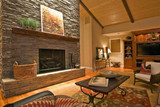Take the First Step Towards Your Dream Home or Garage! Shop Now for Pre-Designed Plans.
Which Type of Fireplace to Consider in Your Home

Incorporating a fireplace can bring both comforting and practical additions to your home. Whether you desire a fireplace unit out of heating necessity or simply to give your house a homier feel, there are a few factors to consider when selecting the type of fireplace for your home. From the three most common fireplace setups, which include woodburning, gas, and pellet stoves, some of these factors include ambiance, installation, heat production and cost effectiveness. Weighing the importance of these will help determine which unit is best for your home.
Masonry or Wood Fireplace
Arguably the most classic fireplace set up, a woodburning unit has both its perks and downfalls. Their biggest plus is the ambiance they provide; the smell of burning wood, crackling sounds, firework-like sparks and dancing yellow and orange flames make for a particularly cozy and nostalgic feel to a home. With controlled combustion units, doors can either be left open in order to enjoy these cozy perks or they can be stocked with wood and left closed to make the most of the heat they produce. However, old houses with old masonry fireplaces aren’t very efficient. For these homes, a fireplace insert is a beneficial idea. These units are designed to fit into an existing masonry fireplace spot. These units additionally require chimney maintenance and regular cleaning. In woodburning fireplaces favor, fire wood is highly available in stores and easily harvestable by hand in more rural areas. They also serve as convenient places to burn combustible litter such as newspaper and small twigs.
Gas Fireplace
The main advantage of gas fireplaces is their convenience. Gas units can be controlled by a remote control or control unit on the wall and are easily installed in odd spaces within the home including walls and corners, whereas woodburning fireplaces are much more restricted. Additionally, while the relative cost of units (wood vs gas) is the same, gas stoves don’t have the cost of chase needed by the chimney for a wood stove. It also doesn’t have the hassle of cleaning and supplying fuel like a wood stove does. Rather, a gas fireplace functions hands free. They come in many versatile styles and many units even feature aesthetic such as fake logs to mimic the ambiance of a woodburning fireplace.
Pellet Stove
Pellet stoves, which take fuel that comes in the form of small pellets made of wood and sawdust, are an additional option for homeowners. These units don’t necessarily require a chimney because they can be ventilated through a small hole in the wall, making them easy to install anywhere, similar to the gas fire places. A downfall to these units is that pellets can be harder to come by than wood logs because they are not necessarily manufactured and sold everywhere, whereas firewood can be found almost anywhere, hand-picked or store bought. However, while pellets may be less readily available and cost slightly more than wood, they do burn longer and have easier clean up.

